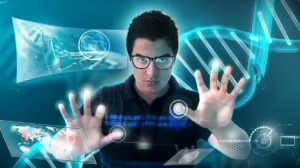Decoding the Digital Age: A Look at the Technology Movement Over the Decades
The evolution of technology has been one of the defining features of the modern age, shaping everything from our daily lives to global economies. From the advent of computers to the rise of the internet and the age of smartphones, the journey through the digital age has been a complex tapestry woven with innovation, disruption, and transformation. This article seeks to elucidate how technology has developed over the decades and its profound impact on society.
The Roots of Modern Technology
The Dawn of Computing: 1940s to 1960s
The story of modern technology begins in the 1940s with the development of the first electronic computers. The ENIAC, completed in 1945, was one of the earliest, marking the beginning of a new era in computational power. Built to calculate artillery firing tables for the United States Army, ENIAC occupied an entire room and weighed over 27 tons. While its applications were limited and primarily governmental, it laid the groundwork for future computing innovations【1】.
The Birth of Personal Computing: 1970s
The 1970s marked a critical turning point with the emergence of personal computers (PCs). Companies like Apple and IBM led the charge, making computing accessible to the general public. The release of the Apple I in 1976 and IBM’s PC in 1981 democratized technology, allowing individuals and small businesses to leverage computing in unprecedented ways【2】【3】.
The Internet Revolution: 1980s to 1990s
With the personal computer came the birth of the internet, which began as a government project but quickly expanded into a global information network. The 1990s saw the commercialization of the internet, enabling businesses to create online presences and transforming how people communicate, shop, and access information. Pioneers like Tim Berners-Lee and Marc Andreessen played vital roles in developing web browsers and applications that would further revolutionize the digital landscape【4】.
The Rise of Mobile Technology: 2000s
Smartphones and Connectivity
The 2000s heralded the smartphone era, fundamentally altering how we interact with technology. The launch of the iPhone in 2007 was a watershed moment that combined a phone, an iPod, and an internet communicator into a single device. Consequently, mobile technology became synonymous with convenience, empowering users to access information and entertainment anywhere and anytime【5】.
Applications and Social Media
The expansion of mobile technology also led to the rise of applications and social media platforms like Facebook, Twitter, and Instagram. These platforms transformed social interaction, giving people the ability to connect and share experiences on a global scale. The surge in user-generated content led to a democratization of information, allowing voices that were once marginalized to find platforms and audiences【6】【7】.
The Era of Big Data: 2010s
Data Analytics and AI
As the digital landscape expanded, so did the amount of data generated. The 2010s introduced the concept of “Big Data,” compelling organizations to harness analytics and artificial intelligence (AI) to decipher vast data sets. Companies began leveraging algorithms to predict consumer behavior, optimize processes, and even enhance decision-making【8】【9】.
The Internet of Things (IoT)
Simultaneously, the Internet of Things (IoT) emerged as a revolutionary force, connecting devices and enabling smart technologies. Household appliances, vehicles, and public infrastructure began to communicate with each other, creating an interconnected web that improved efficiency and convenience【10】.
The Ongoing Digital Transformation: 2020s and Beyond
The Post-Pandemic Tech Boom
The COVID-19 pandemic accelerated the adoption of technology, as remote work and online services became vital for survival. Businesses pivoted to digital platforms, and telehealth, e-learning, and e-commerce experienced unprecedented growth. This era underscored the importance of technological adaptability in an unpredictable world【11】【12】.
The Challenges Ahead
As we advance further into the digital age, emerging technologies such as blockchain, augmented reality, and quantum computing promise to reshape the landscape yet again. However, this rapid evolution also brings challenges, including cybersecurity threats, digital privacy concerns, and the growing digital divide. Ensuring equitable access to technology will be crucial as society continues to navigate these complexities【13】【14】.
Conclusion
The technology movement over the decades has not only redefined industries and economies but has also transformed human interaction and societal norms. As we stand on the brink of new technological frontiers, understanding the trajectory and implications of this evolution will be essential for guiding our future decisions.
References
- “ENIAC: The First Electronic Computer.” IEEE Annals of the History of Computing.
- “The History of Personal Computing.” Computer History Museum.
- “The IBM Personal Computer.” IBM Archives.
- “The Birth of the Internet.” History.com.
- “The Impact of the iPhone on Modern Technology.” Wired.
- “The Rise of Social Media.” Pew Research Center.
- “User-Generated Content: The New Media Model.” Harvard Business Review.
- “Understanding Big Data.” McKinsey & Company.
- “Artificial Intelligence and Data Analytics in Business.” Gartner.
- “Internet of Things (IoT) Overview.” International Telecommunications Union.
- “Technology Adoption During the COVID-19 Pandemic.” World Economic Forum.
- “The Future of Remote Work.” Forbes.
- “Cybersecurity in a Digital Age.” Cybersecurity and Infrastructure Security Agency.
- “Bridging the Digital Divide.” United Nations.
This overview reflects the rich tapestry of technological advancement and its impact on society. As we look forward, continuous innovation and thoughtful policies will be paramount to harness the full potential of technology while addressing the accompanying challenges.


























Add Comment